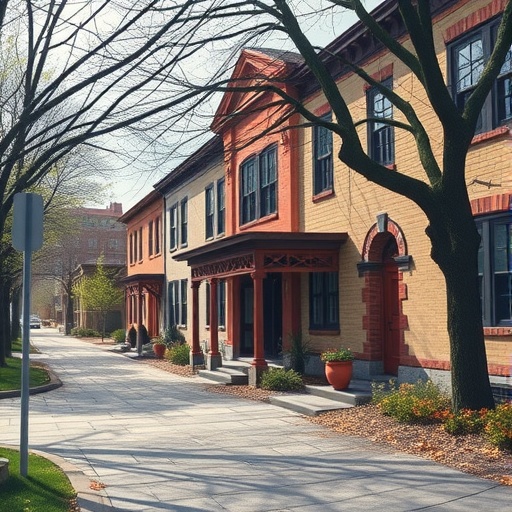A groundbreaking new study from the USC Price School of Public Policy has revealed a stark geographical disparity in access to cultural institutions, which play a pivotal role in fostering social mobility. This research meticulously quantifies the distances that separate lower-income and less-educated neighborhoods from elite cultural amenities, shedding light on the complex barriers faced by these communities. By focusing on metrics such as straight-line distances and expected travel times, the study provides compelling evidence that proximity to cultural capital is unequally distributed, privileging wealthier and more educated populations.
The concept of cultural capital, a term rooted deeply in sociological theory, refers to the accumulation of knowledge, skills, education, and other cultural acquisitions that an individual can leverage to improve their social standing. Despite its importance in economic and social advancement, cultural capital remains unevenly accessible across the urban landscape. This study uniquely captures how geographic factors contribute to these disparities, offering a crucial dimension to understanding inequality beyond simple economic indices.
The research zeroed in on eight representative cultural institutions within the twelve most populous metropolitan areas in the United States. These institutions included libraries, museums, elite universities, Whole Foods stores, Equinox gyms and spas, fine performing arts venues, independent film venues, and art galleries. The choice of these amenities was strategic, as each serves as a tangible embodiment of cultural capital, facilitating learning, exposure, and social networking opportunities essential for upward mobility.
One of the study’s core findings established that neighborhoods with higher educational attainment levels are consistently closer to all eight types of cultural capital. This was true whether distance was measured by the direct “as-the-crow-flies” method or by expected travel times, which incorporate the realities of urban transportation networks. Such a finding suggests systemic urban dynamics that allocate resources and cultural amenities in a way that sustains social stratification rather than alleviating it.
Income disparities mirrored this pattern, with the wealthiest neighborhoods enjoying significantly shorter travel times to cultural institutions than their lower-income counterparts. The implications here are profound: while physical distance is an overt barrier, the added complexity of transportation infrastructure and commuting challenges magnifies this inequality. Consequently, residents of impoverished areas encounter compounded obstacles in accessing venues critical to acquiring the skills and social connections necessary for economic advancement.
The methodology deployed by Professor Elizabeth Currid-Halkett and former doctoral student Andrew Eisenlohr is notable for its rigor and innovation. Rather than relying solely on conventional geographical analyses, they implemented a dual metric approach, assessing both simplistic linear distances and more nuanced travel-time estimates. This bifocal lens allowed them to capture a more accurate representation of accessibility, incorporating elements such as traffic congestion, public transit availability, and urban planning features that affect real-world mobility.
Their work extends beyond mere description, proposing actionable recommendations to transform this landscape of cultural inequality. One such recommendation is to diversify access to elite universities, whose surroundings often constitute cultural hubs replete with museums, libraries, and performing arts venues. By expanding the demographic reach of these academic institutions, the study posits that adjacent communities could gain greater indirect access to vital cultural resources.
Another transformative policy suggestion centers on redistributing affordable housing across different neighborhoods. This approach aims to counteract the entrenched spatial segregation that limits low-income families to peripheral or underserved urban zones. Integrating affordable housing within culturally rich areas could significantly enhance access to indispensable social and educational infrastructures, thereby fostering greater social cohesion and mobility.
Importantly, the study also advocates for educational systems to play a proactive role in mitigating these access gaps. By introducing children and young adults—particularly from disadvantaged backgrounds—to the concept and practical importance of cultural capital, schools can help equip future generations with the tools necessary for navigating and overcoming systemic barriers. This pedagogical emphasis on cultural literacy situates social mobility within the reach of those traditionally marginalized by geography and socioeconomics.
The research highlights a pervasive issue that intertwines urban geography with social inequality, indicating that cultural deserts are not merely accidental but often the result of historical and structural forces. These findings invite policymakers, urban planners, and educators to reconsider how cities are shaped and how resources are distributed, moving toward models that prioritize equitable access to cultural capital as a fundamental aim.
Furthermore, the study’s choice to include amenities like Whole Foods and Equinox gyms underscores a contemporary understanding of cultural capital that extends beyond traditional academic and artistic institutions. These commercial establishments often signify lifestyle markers linked to education and affluence, reflecting broader cultural participation patterns in urban settings. Their inclusion provides a richer, more holistic map of cultural capital distribution, bridging economic and cultural dimensions.
This pioneering research intervenes decisively in the scholarly discourse on social mobility, offering concrete evidence that geographical factors play a critical, measurable role in perpetuating socio-economic disparities. By coupling empirical data with incisive policy recommendations, it lays the groundwork for transformative initiatives aimed at reducing cultural inequities and fostering a more inclusive urban future.
Ultimately, the USC Price School of Public Policy’s study serves as a clarion call to rethink urban cultural landscapes through the lens of accessibility, social justice, and economic empowerment. It challenges stakeholders to envision cities not as divided territories of privilege and marginalization but as interconnected ecosystems where cultural capital is a shared resource driving collective advancement.
Subject of Research: Geographic accessibility to cultural institutions and its impact on social mobility
Article Title: The Geographic Barriers to Cultural Capital and Social Mobility in American Cities
News Publication Date: Not specified
Web References:
https://academic.oup.com/joeg/advance-article-abstract/doi/10.1093/jeg/lbaf040/8268848?redirectedFrom=fulltext
References:
USC Price School of Public Policy study by Professor Elizabeth Currid-Halkett and Andrew Eisenlohr, published in the Journal of Economic Geography.
Keywords: Socioeconomics, Urban planning, Sociological data, Universities, Museums




